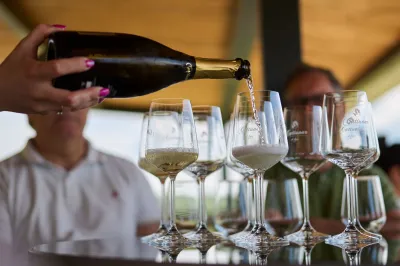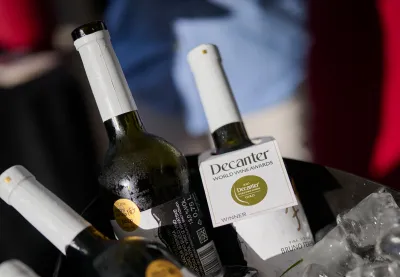Kvarner
Žlahtina
Kvarner is the homeland of Žlahtina, an indigenous grape variety that produces delicate and light wines celebrated for their seductively mild aromas of flowers, citrus and summer apples. This variety gives a wine that is refreshing and light, without strong acids, with delicate structure and body, perfectly smooth.
This region produces around one million bottles of sparkling wine per year, and is the third Croatian region when it comes to sparkling wine production. Their sparkling wines are light, summery with the smell of fruit, yeast and fresh bread, with a pleasant palate. The most famous among them is definitely Bakarska vodica, which was mentioned for the first time in the Wine Laws from 1929.
Sansigot or sušćan
The sandy soil of the island of Susak has preserved the endemic variety sansigot or sušćan from grape phylloxera (Phylloxera vastatrix), which in the 19th century ravaged and destroyed almost all vineyards. Complex wines with a delicate body are produced from this variety, with cherry, blackberry and currant aromas on the nose, and after 8 months of aging in oak barrels, a hint of spice.
Sansigot is the second most common variety in the Kvarner region, and Trojšćina (Uva di Troia) is also cultivated in small quantities, which produces beautiful, lively, pink wines, as well as the varieties Brajdica, Gegić, Žarbola, Belica Meja, Divjak and Verdić.
Kvarner is a priceless combination of sea, islands and mountains in an extremely small area. In just one day, you can sail on a yacht or swim in the sea, and then enjoy the shade of the nearby wooded inland. In winter, you can ski here with a view of the sea, and just a few kilometers away, you can enjoy a swimming pool with sea water, relaxing wellness treatments or long walks along the coast.
Location
Bay in the northern Adriatic, located between the Istrian peninsula and the northern mainland of the Croatian coast.
The largest Croatian islands belong to Kvarner.
Area
3,600 km2
Number of inhabitants
305,000 (Croatian Bureau of Statistics 2021)
Language
Croatian
The highest mountain peaks
Risnjak (1528 meters), Snježnik (1506 meters), Viševica (1428 meters) and Učka (1396 meters).
The largest islands
Krk and Cres, each about 406 km2 in area.
Sea
In the summer months up to 26 °C, in spring and autumn 16 °C, in winter 10 °C.
The salinity of the sea averages from 36 to 38 per thousand.
Rivers
Kupa
Vegetation
Kvarner can take pride in being the richest floristic part of Croatia with 2,700 species. There are as many as 32 protected areas on its territory.
Administrative center
Rijeka (144,000 inhabitants)
Kvarner
Kvarner is located in the north-eastern part of the Adriatic Sea, between Istria and the Croatian coast. It consists of Opatija and its surroundings in the north all the way to Novi Vinodolski in the south. In the area of Kvarner there are 4 larger islands - Krk, Cres, Lošinj and Rab and several smaller ones: Susak, Goli otok, Ilovik, Sv. Grgur, Plavnik and Unije. Kvarner has a 160-year long tradition of tourism, acquired through its originality and variety on offer.
Today, the most famous naturist beaches in this area are those located on the islands of Cres, Krk, Rab and Lošinj. Beautiful beaches, clean sea and well-organized environment are the greatest values of Kvarner as a tourist destination. Kvarner boasts fifteen beaches with the European Blue Flag, which is a symbol of the quality of the offer and the cleanliness of the sea. Kvarner can take pride in being the richest floristic part of Croatia with 2,700 species.
Kvarner is a region of diverse stories and strong emotions. It is an ecologically clean area with a rich cultural and historical heritage and a great tourist offer and active vacation.











































